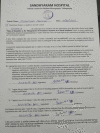The Role of Humidity in the Management of Premature Neonates in a Rural Incubator
- PMID: 33987060
- PMCID: PMC8110649
- DOI: 10.7759/cureus.14411
The Role of Humidity in the Management of Premature Neonates in a Rural Incubator
Abstract
Background While growing inside the uterus, the human fetus floats in amniotic fluid, and the mother maintains a stable temperature of 37 °C and a humidity of 100%. In most neonatal incubators, a stable temperature is maintained but not the humidity. We hypothesised that maintaining a humidity of 70% and a temperature of 32 °C in incubator rooms might improve the outcomes related to low birth weight (LBW) neonates. Methods In this interventional study, 30 preterm LBW neonates delivered at different gestational ages were studied. Instead of an incubator box, we converted one entire room (14'/9'/10') into an incubator. Three 200-watt bulbs were fixed to the wall at a height of 1 meter from babies. The room thermometer was mounted on the wall close to babies. The room temperature was maintained at 32 °C by turning the lights on or off as required. Wet cotton sheets (4' × 6') were spread on the opposite wall with the support of a stand. A hygrometer was fixed to the wall near to babies, and the humidity of the room was maintained at 70-80%. The hydration and nutrition needs of the babies were met with IV fluids/nasogastric (NG) tube feeding. Antenatal steroids were given to all mothers before the completion of 38 weeks. Babies were discharged when they were stable, and further care was given at home with similar arrangements of maintaining temperature and humidity. Birth weights, the number of babies that developed neonatal respiratory distress syndrome (NRDS), hypothermia, septicaemia, neonatal intensive care unit (NICU) admission days, home incubator days, and neonatal deaths were recorded and compared with the findings in the existing literature. Results Among the 30 neonates studied, birth weights ranged from 1.00 to 1.95 kg. Twenty-three babies developed NRDS, and four babies developed septicaemia; NICU days ranged from five to 28 days, and at-home incubator days ranged from 15 to 60 days. One baby succumbed to the illness. Conclusion Open nursing care of functionally premature neonates at room temperature of 32 °C and humidity of 70% is a cost-effective method that can lead to excellent outcomes.
Keywords: cost-effective neonatal care; humidity in a rural incubator; open premature care; rural incubator.
Copyright © 2021, Samartharam et al.
Conflict of interest statement
The authors have declared that no competing interests exist.
Figures




Similar articles
-
Thermal management in closed incubators: New software for assessing the impact of humidity on the optimal incubator air temperature.Med Eng Phys. 2017 Aug;46:89-95. doi: 10.1016/j.medengphy.2017.06.002. Epub 2017 Jun 21. Med Eng Phys. 2017. PMID: 28645849
-
A clinical comparison of radiant warmer and incubator care for preterm infants from birth to 1800 grams.Pediatrics. 2001 Aug;108(2):395-401. doi: 10.1542/peds.108.2.395. Pediatrics. 2001. PMID: 11483805 Clinical Trial.
-
HeatBalance, a computer program to determine optimum incubator air temperature and humidity. A comparison against nurse settings for infants less than 29 weeks gestation.Early Hum Dev. 2001 Apr;62(1):33-41. doi: 10.1016/s0378-3782(01)00112-8. Early Hum Dev. 2001. PMID: 11245993
-
Thermoregulation, incubator humidity, and skincare practices in appropriate for gestational age ultra-low birth weight infants: need for more evidence.World J Pediatr. 2024 Jul;20(7):643-652. doi: 10.1007/s12519-024-00818-x. Epub 2024 Jun 12. World J Pediatr. 2024. PMID: 38864998 Free PMC article. Review.
-
Preterm Infant Incubator Humidity Levels: A Systematic Review.Adv Neonatal Care. 2021 Aug 1;21(4):297-307. doi: 10.1097/ANC.0000000000000791. Adv Neonatal Care. 2021. PMID: 33009156
Cited by
-
Best Practices for Body Temperature Measurement with Infrared Thermography: External Factors Affecting Accuracy.Sensors (Basel). 2023 Sep 21;23(18):8011. doi: 10.3390/s23188011. Sensors (Basel). 2023. PMID: 37766064 Free PMC article.
-
Effect of Neonatal Intensive Care Unit (NICU) Humidity on Neonates: A Systematic Review.Cureus. 2024 Apr 18;16(4):e58524. doi: 10.7759/cureus.58524. eCollection 2024 Apr. Cureus. 2024. PMID: 38765381 Free PMC article. Review.
-
Monitoring System for Operating Variables in Incubators in the Neonatology Service of a Highly Complex Hospital through the Internet of Things (IoT).Sensors (Basel). 2023 Jun 19;23(12):5719. doi: 10.3390/s23125719. Sensors (Basel). 2023. PMID: 37420890 Free PMC article.
References
-
- National, regional, and worldwide estimates of preterm birth rates in the year 2010 with time trends since 1990 for selected countries: a systematic analysis and implications. Blencowe H, Cousens S, Oestergaard MZ, et al. Lancet. 2012;379:2162–2172. - PubMed
-
- WHO: Born Too Soon: The Global Action Report on Preterm Birth. [Apr;2021 ];https://www.who.int/pmnch/media/news/2012/201204_borntoosoon-report.pdf 2012
LinkOut - more resources
Full Text Sources
Other Literature Sources
Miscellaneous
